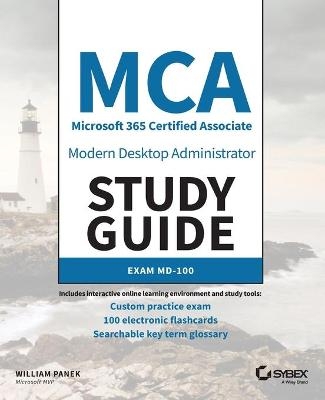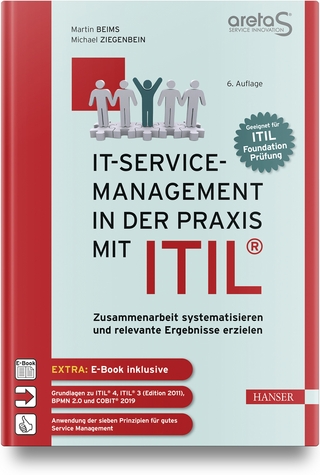
MCA Modern Desktop Administrator Study Guide
Sybex Inc.,U.S. (Verlag)
978-1-119-60590-4 (ISBN)
The new Microsoft 365 Certified Associate (MCA) Modern Desktop certification exam measures a candidate’s ability to deploy Windows, manage devices and data, configure connectivity, and maintain Windows. MCA certification, sought by a growing number of employers, is an important part of any IT professional’s resume.
The MCA Modern Desktop Administrator Study Guide: Exam MD-100 is a must-have book for anyone preparing for certification. This clear and accurate study guide covers 100% of exam objectives—providing hands-on exercises, challenging review questions, full explanations, and real-world examples. From the intricacies of Windows deployment to advanced security and enterprise capabilities, each chapter explains everything candidates need to know for passing the exam and earning MCA certification. This accurate, up-to-date study guide is designed to prepare administrators to deploy, configure, secure, manage, and monitor devices and client applications in an enterprise environment. Access to Sybex's comprehensive online learning environment—comprising a self-assessment test, a bonus practice exam, flashcards, a searchable glossary, and chapter exercise videos—is included to fully prepare for exam day. This study guide:
Covers all Exam: MD-100 objectives
Prepares readers to implement, install, and configure Windows 10
Reinforces comprehension and retention of central exam topics
Helps readers learn new skills or upgrade existing skills to Microsoft's latest desktop client
Demand for competent IT professionals is already high and continues to grow at a rapid pace. The MCA Modern Desktop Administrator Study Guide: Exam MD-100 is a valuable resource for preparing for the new Exam MD-100 and MCA certification.
William Panek, MCP, MCSE, MCSA, MCTS, MCITP, CCNA, is a Five-Time Microsoft MVP Winner. He has taught at Boston University, Clark University, and the University of Maryland, and presently conducts live online classes for StormWind Studios (www.stormwind.com). Will has been a consultant and trainer for the United States Secret Service, Cisco, the United States Air Force, and the United States Army. He also creates training videos to help students prepare for various Microsoft exams.
Introduction xxi
Assessment Test xxxi
Part I Exam MD-100 1
Chapter 1 Windows 10 Installation 3
Understanding the Basics 4
Windows 10 Features 8
Windows 10 Architecture 10
Preparing to Install Windows 10 11
Windows 10 Home 11
Windows 10 Pro 12
Windows 10 Enterprise 13
Windows 10 Enterprise E3 and E5 14
Windows 10 Requirements 14
New Install or Upgrade? 17
Disk Partitioning 20
Language and Locale 21
Installing Windows 10 22
Performing a Clean Install of Windows 10 22
Performing an Upgrade to Windows 10 31
Troubleshooting Installation Problems 36
Supporting Multiple-Boot Options 38
Using Windows Activation 39
Understanding Automated Deployment Options 40
An Overview of the Microsoft Deployment Toolkit 41
An Overview of Unattended Installation 46
An Overview of Windows Deployment Services 48
An Overview of the System Preparation Tool and Disk Imaging 51
Overview of the Windows Assessment and Deployment Kit 55
Windows Configuration Designer 56
Summary of Windows 10 Deployment Options 56
Deploying Unattended Installations 57
Using the System Preparation Tool to Prepare an Installation for Imaging 59
Using Windows Configuration Designer to Create a Disk Image 61
Using the Deployment Image Servicing and Management Tool 63
Using Windows System Image Manager to Create Answer Files 65
Windows Update 66
The Update Process 66
Using Windows Update 68
Using Command-Line Options 69
Installing Windows Store Updates 70
Summary 71
Exam Essentials 72
Video Resources 73
Review Questions 74
Chapter 2 Configuring Users 77
Understanding User Accounts 78
Account Types 79
Built-In Accounts 80
Local and Domain User Accounts 81
Working with User Accounts 82
Using the Local Users and Groups Utility 82
Using the User Accounts Option in Control Panel 84
Creating New Users 85
Disabling User Accounts 90
Deleting User Accounts 91
Renaming User Accounts 93
Changing a User’s Password 94
Using Windows Hello, Pictures, and Biometrics 94
Using Device Guard 95
Understanding Credential Guard 98
Configuring Device Health Attestation 99
Managing User Properties 101
Managing User Group Membership 101
Setting Up User Profiles, Logon Scripts, and Home Folders 103
Troubleshooting User Account Authentication 109
Managing and Creating Groups 110
Using Built-In Groups 111
Creating Groups 115
Managing Group Membership 116
Deleting Groups 118
Managing Security Using GPOs and LGPOs 118
Understanding the GPO and LGPO Basics 118
Using the Group Policy Result Tool 120
Managing and Applying LGPOs 121
Configuring Local Security Policies 123
Using Account Policies 124
Using Local Policies 130
Configuring User Account Control 138
Privilege Elevation 138
Registry and File Virtualization 140
Understanding Smart Cards 140
Configuring Remote Management 143
Remote Assistance 143
Remote Desktop 148
Enabling PowerShell Remoting 150
Configuring a VPN Connection 151
Transparent Caching 153
Broadband Tethering 153
Using PowerShell 155
Summary 157
Exam Essentials 157
Video Resources 157
Review Questions 158
Chapter 3 Managing Data 161
Managing File and Folder Security 162
Folder Options 163
Understanding Dynamic Access Control 167
Securing Access to Files and Folders 168
Determining and Viewing Effective Permissions for NTFS 172
Determining NTFS Permissions for Copied or Moved Files 174
Managing Network Access 174
Creating and Managing Shared Folders 175
Configuring Share Permissions 176
Configuring OneDrive 178
Understanding Hardware Security 181
Using BitLocker Drive Encryption 182
Features of BitLocker 183
Windows 7 vs. Windows 10 185
Using the BitLocker Administration and Monitoring Utility 187
Understanding Smart Cards 188
Summary 188
Exam Essentials 189
Video Resources 189
Review Questions 190
Chapter 4 Managing the Windows 10 Environment 193
Managing Windows 194
Manipulating the Desktop Environment 195
Configuring Personalization 204
Using Control Panel 209
Using the Microsoft Management Console 218
Using the System Icon 219
Understanding the Settings Window 222
Using PowerShell 224
Configuring Mobility Options 225
Configuring Offline Files and Synchronization 225
Configuring Power Policies 227
Configuring Windows to Go 233
Managing Windows 10 Services 236
Configuring Internet Browsers 238
Cortana 239
Browser Controls 240
Pinning Sites to the Taskbar 240
Searchable Address Bar 240
Security and Privacy Enhancements 240
Using the Browser’s Compatibility View 240
Using Protected Mode for IE11 241
Using InPrivate Browsing 242
Configuring Windows Internet Explorer 11 Options 243
Summary 247
Exam Essentials 247
Video Resources 248
Review Questions 249
Chapter 5 Configuring Security and Devices 253
Understanding Filesystems 254
Filesystem Selection 255
Filesystem Conversion 257
Configuring NTFS 258
Configuring Hardware 259
Understanding Devices 259
Using Device Manager 261
Installing and Updating Device Drivers 265
Driver Signing 275
Managing I/O Devices 275
Configuring Removable Storage Devices 275
Managing Printers 278
Configuring Windows Defender Firewall 291
Understanding the Windows Defender Firewall Basics 292
Windows Defender Firewall with Advanced Security 292
Summary 297
Exam Essentials 297
Video Resources 298
Review Questions 299
Chapter 6 Configuring Network Connectivity 301
Understanding the Basics 302
Peer-to-Peer Networks 302
On-site Active Directory Networks 304
Cloud-Based Azure Active Directory 306
Other Microsoft Networking Terms and Roles 306
Configuring NIC Devices 309
Configuring a Network Adapter 310
Troubleshooting a Network Adapter 316
Configuring Wireless NIC Devices 316
Configuring Wi-Fi Direct 324
Understanding TCP/IP 326
Benefits and Features of TCP/IP 327
Basics of IP Addressing and Configuration 329
Using IPv6 Addresses 334
Configuring TCP/IP on Windows 10 344
Testing Your IP Configuration 346
Configuring Windows 10 on a Network 348
Summary 350
Exam Essentials 351
Video Resources 351
Review Questions 352
Chapter 7 Configuring Recovery 355
Understanding Recovery 357
Knowing the Startup/Boot Options 358
Starting in Safe Mode 359
Enabling Boot Logging 362
Using Other Startup Setting Options 364
Understanding System Restore 365
Using the System Image Recovery 366
Using the Startup Repair Tool 367
Maintaining Windows 10 with Backup and Restore 368
Creating a Backup 369
Restoring Files from a Backup 370
Recovering Files from OneDrive 371
Using the Wbadmin Command Utility 372
Using Advanced Backup Options 373
Using System Protection 375
Creating Restore Points 376
Restoring Restore Points 376
Cleaning Up Old Restore Points 377
Using the Recycle Bin 377
Monitoring Windows 378
Introducing Performance Monitor 379
Using Other Performance-Monitoring Tools 388
Summary 397
Exam Essentials 398
Video Resources 399
Review Questions 400
Appendix Answer to Review Questions 403
Chapter 1: Windows 10 Installation 404
Chapter 2: Configuring Users 404
Chapter 3: Managing Data 405
Chapter 4: Managing the Windows 10 Environment 406
Chapter 5: Configuring Security and Devices 407
Chapter 6: Configuring Network Connectivity 408
Chapter 7: Configuring Recovery 409
Index 411
| Erscheinungsdatum | 08.08.2019 |
|---|---|
| Verlagsort | New York |
| Sprache | englisch |
| Maße | 185 x 234 mm |
| Gewicht | 839 g |
| Themenwelt | Informatik ► Weitere Themen ► Zertifizierung |
| Sozialwissenschaften ► Pädagogik | |
| ISBN-10 | 1-119-60590-3 / 1119605903 |
| ISBN-13 | 978-1-119-60590-4 / 9781119605904 |
| Zustand | Neuware |
| Haben Sie eine Frage zum Produkt? |
aus dem Bereich


